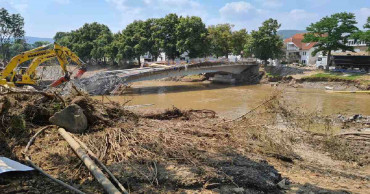Disasters
War in Ukraine, disasters left 71mn people internally displaced in 2022: Report
The war in Ukraine helped push the global total of people left internally displaced by conflict or natural disasters to a record high of 71.1 million last year, according to a report released Thursday by the Norwegian Refugee Council’s Internal Displacement Monitoring Centre.
By the end of 2022, 5.9 million people had been forced to move inside Ukraine because of Russia's invasion, bringing the global total of people internally displaced by conflict and violence to more than 62 million, an increase of 17% since 2021. Syria had 6.8 million displaced by conflict after more than a decade of civil war.
The number of people displaced inside their country at the end of the year because of disasters like floods and famine reached 8.7 million, up by 45% from 2021.
The total of 71.1 million internally displaced worldwide was a 20% increase since 2021.
Internal displacement refers to people forced to move inside their own borders and the Internal Displacement Monitoring Centre's report didn’t take into account those who left for different countries.
Also read: Ukraine's occupied nuke plant faces possible staffing crunch
Following a year when conflict raged in Ukraine, Syria, Ethiopia and elsewhere, there has been no respite in 2023. The United Nations migration agency said this week that 700,000 people have already been internally displaced in a matter of weeks by the conflict in Sudan between the army and a rival paramilitary group.
The Internal Displacement Monitoring Centre cited the La Nina weather phenomenon, which continued for a third consecutive year in 2022, as a major factor in disaster displacements. It contributed to record levels of flood displacement in Pakistan, Nigeria and Brazil and to the worst drought on record in Somalia, Kenya and Ethiopia, the report said.
There was a “perfect storm” of conflict and natural disasters in 2022, leading to “displacement on a scale never seen before,” said Jan Egeland, secretary general of the Norwegian Refugee Council.
2 years ago
113 actions under NAP to be implemented to deal with disasters: Environment Minister
Environment, Forest and Climate Change Minister Md. Shahab Uddin said 113 adaptive actions have been identified in the National Adaptation Plan(NAP)to deal with 14 types of disasters by dividing Bangladesh into 11 regions.
Of these, 80 are considered as high priority and 23 as medium priority actions.
The minister said these at a workshop titled 'Consultation Workshop on Dissemination and Brainstorming of NAP Implementation' organised by the Ministry of Environment, Forest and Climate Change in the auditorium of the Department of Environment.
“To implement the activities identified in the Adaptation Plan by 2050, we will need around US$230 billion,” he said.
The workshop was presided over by the Secretary of the Ministry Dr. Farhina Ahmed.
Additional Secretary of Climate Change wing of the ministry Md. Moniruzzaman, Director General of Department of Environment Dr. Abdul Hamid and Professor Emeritus Dr. Ainun Nishat spoke at the workshop.
Read more: Single-use plastic will be reduced by 90% within 2026: Environment Minister
NAP was presented by Deputy Secretary(CC) Dharitri Kumar Sarkar and Director of DoE Mirza Shawkat Ali.
The high officials present at the workshop placed their respective suggestions to implement NAP successfully.
The Minister said that the plan submitted to the UNFCCC on October 31, 2022 is not only a national report but it will highlight the country’s position in the global arena in terms of climate adaptation.
“This plan will be implemented by accepting everyone's valuable opinions. This National Adaptation Plan will be effective in adopting and implementing long-term integrated adaptation activities to combat climate change in Bangladesh,” he said.
The National Adaptation Plan identifies specific adaptation needs for Bangladesh and appropriate strategies to implement them, he added.
Shahab Uddin said that in addition to infrastructural development to deal with the impact of climate change, more emphasis will be given in increasing the adaptive capacity of people in vulnerable areas.
Adaptation activities identified in the National Adaptation Plan will be adopted and implemented through collective efforts to combat climate change impacts, the minister added.
2 years ago
Weary of many disasters? UN says worse to come
A disaster-weary globe will be hit harder in the coming years by even more catastrophes colliding in an interconnected world, a United Nations report issued Monday says.
If current trends continue the world will go from around 400 disasters per year in 2015 to an onslaught of about 560 catastrophes a year by 2030, the scientific report by the United Nations Office for Disaster Risk Reduction said. By comparison from 1970 to 2000, the world suffered just 90 to 100 medium to large scale disasters a year, the report said.
The number of extreme heat waves in 2030 will be three times what it was in 2001 and there will be 30% more droughts, the report predicted. It’s not just natural disasters amplified by climate change, it’s COVID-19, economic meltdowns and food shortages. Climate change has a huge footprint in the number of disasters, report authors said.
Also read: Despite emissions growth slowing, window for climate action 'closing fast': UN body
People have not grasped how much disasters already cost today, said Mami Mizutori, chief of the UN Office of Disaster Risk Reduction, “If we don't get ahead of the curve it will reach a point where we cannot manage the consequences of disaster,” she said. “We're just in this vicious cycle.”
That means society needs to rethink how it finances, handles and talks about the risk of disasters and what it values the most, the report said. About 90% of the spending on disasters currently is emergency relief with only 6% on reconstruction and 4% on prevention, Mizutori said in an interview Monday.
Not every hurricane or earthquake has to turn into a disaster, Mizutori said. A lot of damage is avoided with planning and prevention.
In 1990, disasters cost the world about $70 billion a year. Now they cost more than $170 billion a year, and that’s after adjusting for inflation, according to report authors. Nor does that include indirect costs we seldom think about that add up, Mizutori said.
For years disaster deaths were steadily decreasing because of better warnings and prevention, Mizutori said. But in the last five years, disaster deaths are “way more” than the previous five years, said report co-author Roger Pulwarty, a U.S. National Oceanic and Atmospheric Administration climate and social scientist.
Also read: Twitter bans ads that contradict science on climate change
That's because both COVID-19 and climate change disasters have come to places that didn't used to get them, like tropical cyclones hitting Mozambique, Mizutori said. It's also the way disasters interact with each other, compounding damage, like wildfires plus heatwaves or a war in Ukraine plus food and fuel shortages, Pulwarty said.
Pulwarty said if society changes the way it thinks about risk and prepares for disasters, then the recent increase in yearly disaster deaths could be temporary, otherwise it’s probably “the new abnormal."
Disasters are hitting poorer countries harder than richer ones, with recovery costs taking a bigger chunk out of the economy in nations that can’t afford it, co-author Markus Enenkel of the Harvard Humanitarian Initiative said.
“These are the events that can wipe out hard-earned development gains, leading already vulnerable communities or entire regions into a downward spiral,” he said.
The sheer onslaught of disasters just add up, like little illnesses attacking and weakening the body's immune system, Pulwarty said.
The report calls for an overhaul in how we speak about risk. For example, instead of asking about the chances of a disaster happening this year, say 5%, officials should think about the chances over a 25-year period, which makes it quite likely. Talking about 100-year floods or chances of something happening a couple times in 100 years makes it seem distant, Mizutori said.
“In a world of distrust and misinformation, this is a key to moving forward,” said University of South Carolina Hazards Vulnerability and Resilience Institute Co-Director Susan Cutter, who wasn’t part of the report. “We can move forward to reduce the underlying drivers of risk: Inequality, poverty and most significantly climate change.”
3 years ago
At least 3 dead in apparent gas explosion in north China
An apparent gas explosion gutted part of a high rise in northern China on Thursday morning, killing at least three people and injuring 30.
It occurred at a hotel in Shenyang, a city of more than 8 million people and a major industrial center that is in the process of renovating and replacing decaying gas lines, state media reported.
Images posted online by news website The Paper and state broadcaster CCTV showed a cloud of dust and debris blowing onto a busy street, leaving the bottom three floors of the building a gutted shell. Concrete blocks were piled in the street and a three-wheeled delivery vehicle lay on its side.
Read: China's economic growth weakens amid construction slowdown
China is replacing decades-old infrastructure, with gas lines an especially dangerous part of the project. In June, a gas line explosion at a market and residential area in the central city of Shiyan killed 25.
That blast appeared similar to one that occurred in the northeastern port of Qingdao in 2013, in which 55 people were killed when underground pipelines ripped open following a leak.
Along with the deteriorations caused by age, weak adherence to safety standards, poor maintenance and corruption among enforcement bodies are all considered contributors to such disasters. Among China's worst accidents was a massive 2015 explosion at a chemical warehouse in the port city of Tianjin that killed 173 people, most of them firefighters and police officers.
4 years ago
Residents say flood-hit German towns got little warning
Like other residents of his town in Germany, Wolfgang Huste knew a flood was coming. What nobody told him, he says, was how bad it would be.
The 66-year-old antiquarian bookseller from Ahrweiler said the first serious warning to evacuate or move to higher floors of buildings close to the Ahr River came through loudspeaker announcements around 8 p.m. on July 14. Huste then heard a short emergency siren blast and church bells ringing, followed by silence.
Read:Germany defends preparation for floods, considers lessons
“It was spooky, like in a horror film,” he said.
Huste rushed to rescue his car from an underground garage. By the time he parked it on the street, the water stood knee height. Five minutes later, safely indoors, he saw his vehicle floating down the street. He estimates the losses in his store, where books dating back to the early 1500s were destroyed, at more than 200,000 euros ($235,000).
“The warning time was far too short,” Huste said.
With the confirmed death toll from last week’s floods in Germany and neighboring countries passing 210, almost 150 people still missing and the economic cost expected to run into the billions, many have asked why the emergency systems designed to warn people of impending disaster didn’t work.
Sirens in some towns failed when the electricity was cut. In other locations, there were no sirens at all; volunteer firefighters had to knock on people’s doors to tell them what to do. The German weekly Der Spiegel reported that in one suburb of Wuppertal, north of Cologne, people were warned by a monk ringing a bell.
Huste acknowledged that few could have predicted the speed with which the water would rise and rip through towns. But he pointed across the valley to a building that houses Germany’s Federal Office for Civil Protection, where first responders from across the country train for possible disasters.
“In practice, as we just saw, it didn’t work, let’s say, as well as it should,” Huste said. “What the state should have done, it didn’t do. At least not until much later.”
German authorities did receive early warnings from the European Flood Awareness System. These made their way through official channels, putting firefighters on heightened alert as well as smartphone users who had installed disaster warning apps, but such apps aren’t widely used.
Local officials responsible for triggering disaster alarms in the Ahr valley on the first night of flooding have kept a low profile since the deluge. At least 132 people were killed in the Ahr valley alone.
Authorities in Germany’s Rhineland-Palatinate state took charge of the disaster response in the wake of the floods, but they declined to comment on what mistakes might have been made on the night the disaster struck.
Read:Merkel tours ‘surreal’ flood scene, vows aid, climate action
“People are looking at a life in ruins here. Some have lost relatives, there were many dead,” said Thomas Linnertz, the state official now coordinating the disaster response. “I can understand the anger very well. But on the other hand, I have to say again: This was an event that nobody could have predicted.”
The head of Germany’s federal disaster agency BKK, Armin Schuster, acknowledged to public broadcaster ARD that “things didn’t work as well as they could have.”
His agency is trying to determine how many sirens were removed after the end of the Cold War. Germany also plans to adopt a system known as ‘cell broadcast’ that can send alerts to all cellphones in a particular area.
In the town of Sinzig, Heiko Lemke recalled how firefighters came knocking on doors at 2 a.m., long after the floods had caused severe damage upriver in Ahrweiler.
Despite a heavy flood in 2016, nobody had expected the waters of the Ahr River to rise as high as they did in his community, Lemke said.
“They were evacuating people,” he said. “We were totally confused because we thought that wasn’t possible.”
Within 20 minutes, water had flooded the ground floor of his family’s house, but they decided it was too dangerous to venture out, he said.
“We wouldn’t have managed to make it around the corner,” said his wife, Daniela Lemke.
Twelve residents of a nearby assisted living facility for people with disabilities drowned in the flood. Police are probing whether staff at the facility could have done more to save the residents, but so far there is no suggestion that authorities could face a criminal investigation for failing to issue timely warnings.
Read:Europe flooding toll over 180 as rescuers dig deeper
Experts say such floods will become more frequent and severe due to climate change, and countries will need to adapt, including by revising calculations about future flood risks, improving warning systems and preparing people for similar disasters.
Now that he knows about the flood risk, Heiko Lemke hopes all those things will happen.
“But maybe it would be even better to leave,” he added.
4 years ago


.jpg)
.jpg)



